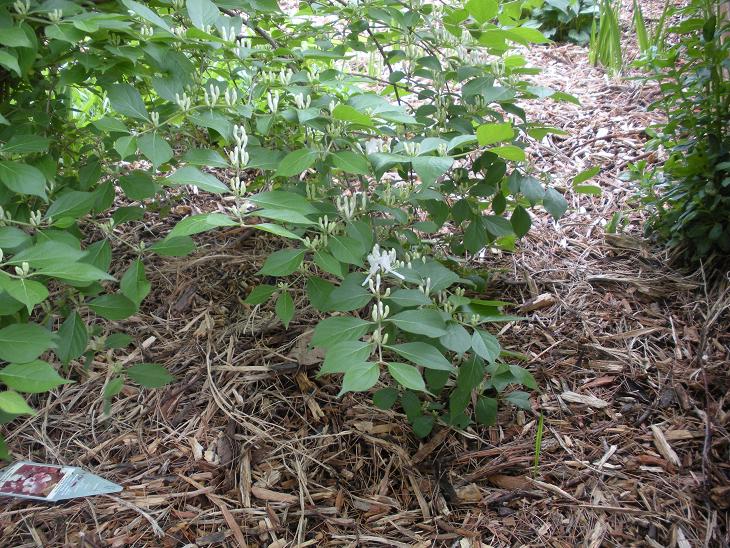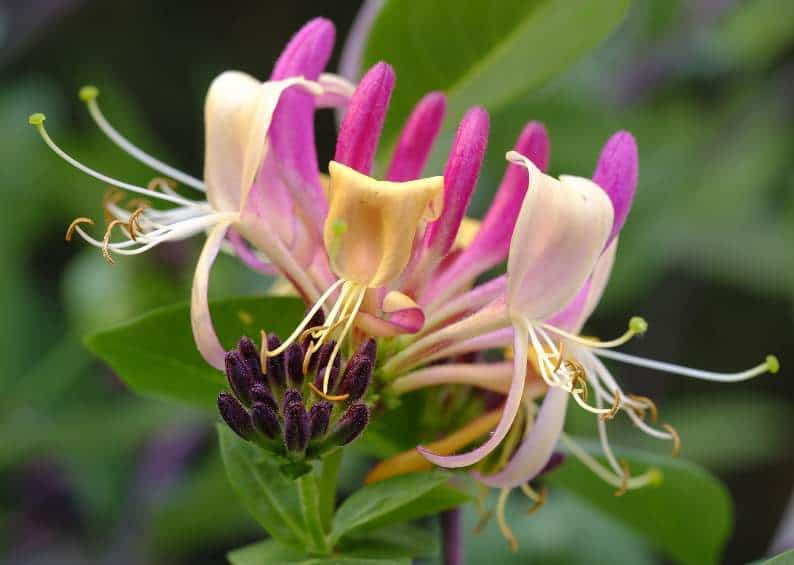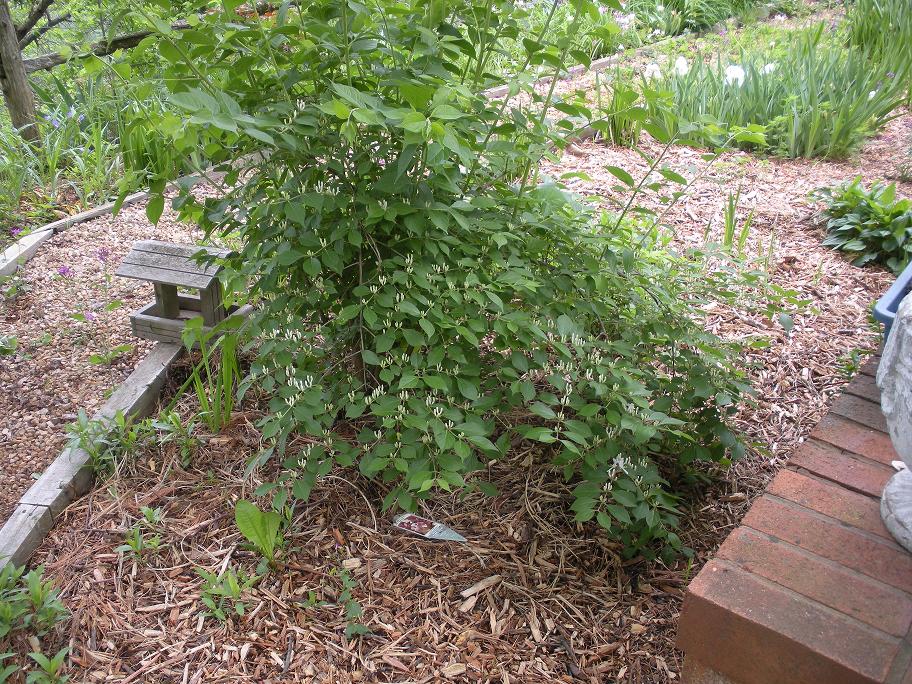Usually, pruning at the incorrect time of year or pruning too severely prevents honeysuckle from blooming. When honeysuckle is pruned in the early spring, the growth on which it blooms is removed, leaving vines with loads of foliage but no flowers. Honeysuckle flowers on growth from the previous year.
The following are the top 6 causes of honeysuckle not blooming:
- trimming the vines too forcefully or at the wrong time of year.
- With fewer blooms, excessive fertilizer encourages the growth of foliage.
- A lack of nutrients in the soil might stop flowers from blooming.
- The honeysuckle vine’s inability to get enough sun limits blossoming.
- Before blooming, honeysuckles might take up to three years to reach maturity.
- The honeysuckle does not bloom if the soil is too dry.
Continue reading to find out more about the reasons why your honeysuckle isn’t blooming and how to put the best strategies and fixes (that really work) into practice so your honeysuckle blooms the next year.
Table of Contents
1. Pruning Honeysuckle at the Wrong Time Prevents Flowering
Your honeysuckle vines may not flower if you make one of these two typical pruning errors:
- honeysuckle pruning too early or too late in the growing season. The majority of early-flowering honeysuckle varieties bloom on the vines and shoots from the previous season; most varieties do not bloom on new growth. All of the growth from which the honeysuckle shows its flowers can be pruned back in the winter or early spring.
- overly severe honeysuckle pruning. Heavy pruning of honeysuckle encourages long, lush vines and lots of fresh green growth, but far fewer blooms.
Annual pruning of honeysuckle plants is beneficial for keeping their shape, encouraging flowering vines, and preventing them from growing into unmanageable thickets.
To encourage flowers and avoid removing the growth that will support the blooms for the following year, it is crucial to trim your honeysuckle back at the proper period.
Right after the blooms have fallen is the best time to prune honeysuckle. The precise timing to prune depends on the variety of honeysuckle you have because various varieties flower at different periods of the year.
Your honeysuckle should be pruned back to retain shape and to encourage the vines to grow around any supports, such as a trellis, wall, or frame. You should also prune back any overgrown vines that appear untidy to prevent crowded development, which can also prevent blossoming.
The better for blossoming is a honeysuckle that has been pruned lightly while yet maintaining a neat vine.
It should be noted that old dead wood that is no longer producing vines or growing can be hard pruned at any time of the year.
As a result, the plant receives more light and ventilation and doesn’t end up looking like a tangled mess.
When neglected and overgrown, honeysuckle is a tough plant that can withstand a rigorous pruning to enhance its shape, but it may take up to two years before you notice a beautiful bloom show.
2. Too Much Fertilizer Reduces Honeysuckle Flowering
A wild shrub called honeysuckle does best in healthy soil that has plenty of organic matter.
The honeysuckle can benefit from fertilizer to increase growth and encourage flowering.
Strong fertilizers or frequent fertilizer applications should be avoided, though, as they encourage the growth of vines and foliage at the expense of flowers.
A honeysuckle often only needs one dose of slow-release all-purpose fertilizer at the start of spring (after the fear of frost) (assuming the honeysuckle is planted in good soil with lots of organic matter).
When too much fertilizer has been used, honeysuckle tends to grow quickly, developing long vines and a lot of foliage.
Occasionally, too much nitrogen from lawn fertilizer might wash into garden borders after a lot of rain and harm your honeysuckle (as well as other plants).
So even if you haven’t specifically given fertilizer to your honeysuckle, the fact that it isn’t flowering could be due to water-soluble nitrogen runoff from lawn treatments into the soil surrounding your honeysuckle.
There isn’t much you can do to encourage blossoming this season once fertilizer has been applied; you might have to wait until the following year for flowers.
Since it contains all the nutrients your honeysuckle needs at the proper concentration for flowering and the nutrients are released gradually, reducing the risk of overfertilizing, I personally recommend miracle-gro all-purpose granule fertilizer. This will ensure that the honeysuckle has access to all the resources it needs for flowering.
3. Not Enough Nutrients for Honeysuckle to Bloom
Native to woodlands, honeysuckle thrives on humus-rich soil and receives a yearly dose of mulch in the form of leaf litter.
Some gardens with nutrient-rich soil only need to apply mulch around the base of the honeysuckle to encourage flowering.
However, if any of the following situations arise:
- Sand is in your garden soil (sand does not retain water soluble nutrients).
- A pot or other container contains the honeysuckle (the roots can exhaust the potting mix of nutrients).
- The honeysuckle is surrounded by plants that compete with it for nutrition or placed next to a tree.
An application of mulch can assist to conserve moisture, enhance soil structure, and give nutrients to the soil, which can help increase flowering, whether your honeysuckle is in a pot, beneath a tree, or in sandy soil.
Apply a one-inch layer of mulch (ideally compost or leaf mold) at the base of your honeysuckle in the spring to improve the honeysuckle’s flowering prospects.
However, in poor soil or if the honeysuckle roots are competing with tree roots for nutrients, applying mulch alone is often insufficient to significantly increase the likelihood that honeysuckle vines will flower. Instead, fertilizer must be used.
I would advise using Mircle-gro granules because they deliver their nutrients gradually without harming your honeysuckle’s roots.
The amount of flowers on display the next year should grow with regular applications of mulch in the spring along with some slow release fertilizer.
Yellowing leaves and leaf loss are additional signs of low nutrition levels and dryness. Read my post Why is my honeysuckle dying for advice on how to save your honey suckle if it exhibits these signs.
4. Not Enough Sun For Flowering
A wild plant, honeysuckle climbs trees and hedging to seek sunlight, giving it the energy it needs to bloom.
If your honeysuckle isn’t blooming, it can be too heavily shaded where it’s been placed.
If the honeysuckle is planted in complete shadow, the leaves may drop and the plant may frequently wither away.
The soil should be in the shade (so that the roots stay cool and the soil maintains moisture) and the vines should be in the sun (which promotes flowering) for blossoming honeysuckle.
For a nice flower display, partial sun or dappled light throughout the day is frequently sufficient; however, full shadow on the entire plant throughout the summer drastically inhibits flowering.
If your honeysuckle isn’t blooming and it’s in a dark place, think about pruning any overhanging tree limbs that are blocking the sun. Alternatively, if the honeysuckle was just planted, you might be able to move it to a sunnier spot.
5. Honeysuckle is not Mature Enough to Flower
If the honey suckle is a small plant, it frequently takes up to three years for it to start blooming after being newly planted.
After being planted, honeysuckles need time to establish their root system in the soil and grow their vines around the supporting structure. These processes take time to complete.
They spend their first few years in the woodland habitat growing up trees and hedgerows so that their vines are in full sun. The vines that receive the most sunlight blossom more frequently.
If the parameters listed below are met, your honeysuckle should bloom after two or three years:
- a self-supporting structure, such as a tree, fence, or trellis.
- climbing vines that receive at least 6 hours of sunlight daily in the summer.
- before planting, soil that has been modified with organic material to help retain moisture
- soil that doesn’t dry out and remains continually moist. (Water once a week till it becomes established over the summer.)
- sufficient nutrition for blossoming.
- Till you’re established, avoid severe pruning. Instead, use wire and hooks to train the vines around the framework to create the appropriate shape.
Your honeysuckle should produce an abundance of blossoms the following summer if it has been established after being planted for around three years and the growing circumstances are favorable.
6. Dry Soil Stops Honeysuckle Flowering
Honeysuckle normally grows in wooded areas where the soil is rich in decomposed leaf litter, which aids it retaining moisture even during hot, dry summers.
The soil near honeysuckle may be too dry for a number of reasons:
- The honeysuckle’s roots are in a rain shadow. The climbing vines of honeysuckle need a structure to climb up, but fences and walls frequently have a dry area directly underneath where rain is deflected away by the structure. This is especially true if the prevailing winds cause the rain to divert at an angle, leaving a small patch of dry soil around your honeysuckle.
- Less moisture is retained by sandy soil. Naturally, certain garden soils are more stony or sandier than others. After rain, sand and stone commonly speed up the drainage process, drying out the soil before the roots have a chance to absorb moisture.
- Tree roots and honeysuckle are in competition for moisture. As they have evolved to grow in this way, honeysuckles thrive when used as a supporting framework by specific trees. However, certain tree species are especially thirsty and can be vying with the roots of the honeysuckle for soil moisture. Willow, birch, and pine trees all have high moisture requirements, which can result in dry soil where your honeysuckles’ roots are attempting to absorb moisture.
- Your honeysuckle’s roots are receiving sun. When there is sun on the vines and it is somewhat cool, shaded, and wet where the roots are, honeysuckle normally grows well. If the roots are exposed to direct sunlight, this can heat up the soil and cause excessive soil evaporation. This causes the roots to dry out and get stressed, which can impede blossoming.
- In pots or other containers, honeysuckle Although I have seen honeysuckle growing well in pots and containers, the pot or container needs to be large enough to hold adequate soil for the roots to be able to absorb moisture. Since pots and containers often drain well and can dry out in the summer, careful watering is necessary to prevent flower failure.
It is simple to improve the conditions for your garden’s drought-stricken honeysuckles with a few simple changes.
- The honeysuckle should, ideally, be planted in soil that has been treated with a lot of compost, leaf mold, or well-rotted manure because these substances have a high moisture-retentive capacity.
- The primary factor in increasing the likelihood of flowering is to water the honeysuckle well during the summer for the first three years while it is establishing.Once a week, give the honeysuckle a good soak, ideally with a hose. A weekly watering is not required outside of the growing season.
- A thick layer of compost or leaf mold mulch, which helps the soil retain moisture, improves the soil’s structure, and adds nutrients, should be applied around the base of the honeysuckle to increase the likelihood that it will bloom.
- The best technique is to give the soil a good soak once a week if your soil is sandy, trees are vying for moisture, or the honeysuckle is in a rain-shadow. You should also add mulch periodically if any of these conditions apply to your situation. As the mulch is gradually absorbed into the soil, the soil’s ability to hold moisture should considerably increase. Consider applying mulch as a way to mimic the benefits of leaf litter in a woodland setting.
Avoid mild watering as this promotes the roots to develop shallow in the soil. Watering liberally stimulates the honey suckle’s roots to establish so it may tap into moisture reserves in the soil to strengthen its resistance to drought.
You may recreate your honeysuckle’s optimal soil and moisture conditions by adding mulch to the soil and watering it in the spring and summer. This should give your plant everything it needs to produce blossoms on its vines.
Key Takeaways:
- If honeysuckle has been severely clipped or cut at the incorrect time of year, it will not bloom. Because honeysuckle flowers are developed on the previous year’s growth, pruning too early can unintentionally remove the flower buds and stop the honeysuckle from blossoming.
- A surplus of fertilizer encourages vine growth and loads of foliage, but very few blooms.
- The honeysuckle may have trouble flowering in gardens with plenty of trees competing for nutrients or in soil that is deficient in nutrients.
- When exposed to greater sunlight, honeysuckle plants produce more flowers. If your honeysuckle is shaded throughout the summer, move it to a spot that receives more sunlight, or trim back any nearby trees or plants that are creating shadow.
- After planting, honeysuckle may not bloom for three years. Before blooming, honeysuckles need time to develop their root system and expand their vines to receive more sunshine.
- If honeysuckle is affected by drought, it might not bloom. The abundance of leaf litter at the foot of woodlands where honeysuckles thrive helps to keep the soil moist. If the soil is dry, add mulch around the honeysuckle’s base and water frequently.
FAQ
How do I get my honeysuckle to bloom?
If the honeysuckle receives enough light, it will blossom more. With six to eight hours of light every day, Eastern exposure is the finest possible. In horticulture, however, there is a fundamental principle about plants not performing properly. Cut it back severely if it can be pruned.
Why is my honeysuckle bare?
honeysuckle pruning done carelessly The fact that sunlight cannot reach the lower branches of neglected and excessively overgrown honeysuckle vines is another issue. When this occurs, the lower branches lose their leaves, leaving the stems bare.
Why are there no flowers on my honeysuckle?
There are a number of potential causes for honeysuckle not to flower, including: Insufficient lighting For the majority of honeysuckle plants, full sun is typically advised. Plant juvenility: Plants may flower during their first season, but they may need up to three seasons to settle before putting on an acceptable amount of development.
What month does honeysuckle bloom?
The majority of honeysuckle cultivars bloom in the spring and emit scent far into the summer. Depending on the USDA plant hardiness zone the plant is growing in, honeysuckle should flower any time between late March and May.
How do I get my honeysuckle vine to bloom?
Make sure your honeysuckle is in a location that receives direct sunlight to keep the plant flowering. In shaded areas, honeysuckle will still grow but not bloom as much. 6 or more hours of sunlight per day is considered full sun.



